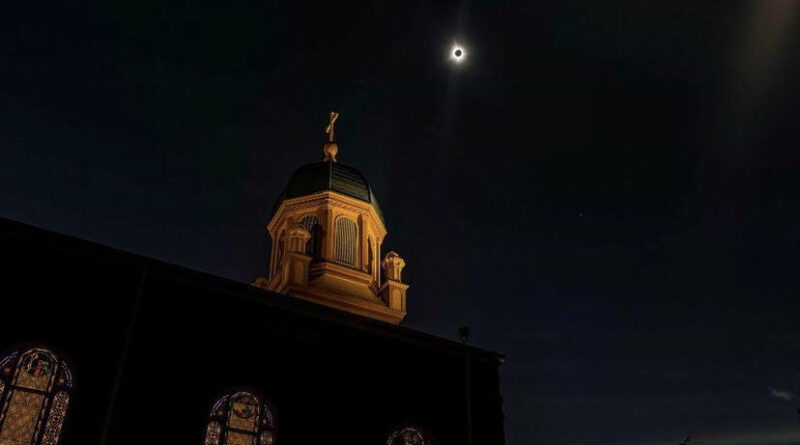Total eclipse ‘5,000 times more awesome,’ UD physics prof says
Pictured is the Eclipse in totality over the University of Dayton. Photo courtesy of Ellis Dunn ’25 for the University of Dayton’s Instagram.
Samantha Neveril | Contributing Writer
Millions of Americans gazed at the sky in disbelief Monday as a total solar eclipse made its way over 15 of the 50 U.S. states.
While a partial solar eclipse was visible in the contiguous 48 states, not everyone had the privilege of seeing the moon completely block the sun for several minutes.
Dayton was one of the cities along the eclipse’s path where full totality could be seen. This resulted in thousands of people traveling to the Dayton area to witness the rare celestial event firsthand.
Dayton residents, including University of Dayton students and faculty members, were lucky enough to view the eclipse without having to travel very far, if at all.
In anticipation of the eclipse, UD canceled all academic classes held between 1:25-4:50 p.m. Instead, UD community members were invited to gather on the Central Mall to observe the event, listen to music and enjoy solar eclipse-themed food.
Jason Deibel, the chair of UD’s physics department, was among the many spectators enjoying the activities on the Central Mall.
Deibel, who has a doctorate in applied physics, said in an interview Monday afternoon, “This is a great opportunity to get people engaged in science. We don’t have many scientific events that people say, ‘hey let’s go get excited for,’ you know?”
Like some of the other eclipse viewers, Diebel had previously seen a partial eclipse in 2017 but had never witnessed a total eclipse before. He said he knew this one was going to be “5,000 times more awesome.”
Deibel watched the 2017 partial eclipse from his backyard after his son’s first day of preschool. This year, as a member of UD’s eclipse committee, he was able to bring over 1,000 UD community members together to witness a phenomenon they had never seen before.
Numerous eclipse observers knew the event was going to be astonishing because of the science behind it, but something that also surprised people was the way it brought the community together.
“The eclipse surpassed my expectations, and I have to tell you part of the reason it surpassed was because of the community here,” Cassandra Secrease, a full-time lecturer for the communication department, said Monday.
Secrease watched the eclipse surrounded by some of her colleagues, students and other community members. This made the experience more special for her.
“This was an amazing experience, and I think if I would have been sitting at home by myself, it would have been cool, but it would not have been like this,” Secrease explained.
Similarly, professor Stephanie Sweet, who is also a full-time lecturer for the communication department, described how watching the eclipse with others led her to really appreciate the experience.
“I think anything that brings us together, not just as a UD community but even as a wider community is really important,” Sweet said at the eclipse celebration Monday.
“One of the things that I loved so much when we were all viewing that was the presence, and this like quietness and just people enjoying that together. I think that is something we need a lot of, just leaning in and coming together, so I loved that,” she added.
Before Monday’s event, the last total solar eclipse that could be seen in Ohio happened in 1806. Ohio’s next total eclipse will not occur until 2099, making Monday’s eclipse a historic event for the city of Dayton, UD and all who witnessed it.
For more coverage of the Eclipse at UD check out our campus page here.

